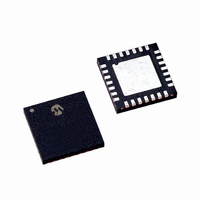PIC18F25J11-I/ML Microchip Technology, PIC18F25J11-I/ML Datasheet - Page 375

PIC18F25J11-I/ML
Manufacturer Part Number
PIC18F25J11-I/ML
Description
IC PIC MCU FLASH 32K 2V 28-QFN
Manufacturer
Microchip Technology
Series
PIC® XLP™ 18Fr
Datasheets
1.MA180023.pdf
(528 pages)
2.PIC18LF24J10-ISS.pdf
(32 pages)
3.PIC18F24J11-ISS.pdf
(14 pages)
Specifications of PIC18F25J11-I/ML
Core Size
8-Bit
Program Memory Size
32KB (16K x 16)
Core Processor
PIC
Speed
48MHz
Connectivity
I²C, SPI, UART/USART
Peripherals
Brown-out Detect/Reset, POR, PWM, WDT
Number Of I /o
16
Program Memory Type
FLASH
Ram Size
3.8K x 8
Voltage - Supply (vcc/vdd)
2.15 V ~ 3.6 V
Data Converters
A/D 10x10b
Oscillator Type
Internal
Operating Temperature
-40°C ~ 85°C
Package / Case
28-VQFN Exposed Pad, 28-HVQFN, 28-SQFN, 28-DHVQFN
Controller Family/series
PIC18
No. Of I/o's
16
Ram Memory Size
3.6875KB
Cpu Speed
48MHz
No. Of Timers
5
Interface
EUSART, I2C, SPI
Processor Series
PIC18F
Core
PIC
Data Bus Width
8 bit
Data Ram Size
3776 B
Interface Type
EUSART, I2C, SPI
Maximum Clock Frequency
48 MHz
Number Of Timers
5
Maximum Operating Temperature
+ 85 C
Mounting Style
SMD/SMT
3rd Party Development Tools
52715-96, 52716-328, 52717-734, 52712-325, EWPIC18
Development Tools By Supplier
PG164130, DV164035, DV244005, DV164005, PG164120, DM183022, DM183032, DV164136, MA180023
Minimum Operating Temperature
- 40 C
On-chip Adc
10 bit, 10 Channel
Lead Free Status / RoHS Status
Lead free / RoHS Compliant
For Use With
AC164322 - MODULE SOCKET MPLAB PM3 28/44QFN
Eeprom Size
-
Lead Free Status / Rohs Status
Details
Available stocks
Company
Part Number
Manufacturer
Quantity
Price
Company:
Part Number:
PIC18F25J11-I/ML
Manufacturer:
MICROCHIP
Quantity:
4 000
- Current page: 375 of 528
- Download datasheet (8Mb)
24.1.5
The CTMU sets its interrupt flag (PIR3<2>) whenever
the current source is enabled, then disabled. An inter-
rupt is generated only if the corresponding interrupt
enable bit (PIE3<2>) is also set. If edge sequencing is
not enabled (i.e., Edge 1 must occur before Edge 2), it
is necessary to monitor the edge status bits and
determine which edge occurred last and caused the
interrupt.
24.2
The following sequence is a general guideline used to
initialize the CTMU module:
1.
2.
3.
4.
5.
6.
7.
8.
9.
10. Clear the Edge Status bits: EDG2STAT and
11. Enable both edge inputs by setting the EDGEN
© 2009 Microchip Technology Inc.
Select the current source range using the IRNG
bits (CTMUICON<1:0>).
Adjust the current source trim using the ITRIM
bits (CTMUICON<7:2>).
Configure the edge input sources for Edge 1 and
Edge 2 by setting the EDG1SEL and EDG2SEL
bits (CTMUCONL<3:2 and 6:5>).
Configure the input polarities for the edge inputs
using the EDG1POL and EDG2POL bits
(CTMUCONL<4,7>). The default configuration
is for negative edge polarity (high-to-low
transitions).
Enable edge sequencing using the EDGSEQEN
bit
sequencing is disabled.
Select the operating mode (Measurement or
Time Delay) with the TGEN bit. The default
mode is Time/Capacitance Measurement.
Discharge the connected circuit by setting the
IDISSEN bit (CTMUCONH<1>); after waiting a
sufficient time for the circuit to discharge, clear
IDISSEN.
Disable the module by clearing the CTMUEN bit
(CTMUCONH<7>).
Enable the module by setting the CTMUEN bit.
EDG1STAT (CTMUCONL<1:0>).
bit (CTMUCONH<3>).
CTMU Module Initialization
(CTMUCONH<2>).
INTERRUPTS
By
default,
edge
PIC18F46J11 FAMILY
Depending on the type of measurement or pulse
generation being performed, one or more additional
modules may also need to be initialized and configured
with the CTMU module:
• Edge Source Generation: In addition to the
• Capacitance or Time Measurement: The CTMU
• Pulse Generation: When generating system clock
24.3
The CTMU requires calibration for precise measure-
ments of capacitance and time, as well as for accurate
time delay. If the application only requires measurement
of a relative change in capacitance or time, calibration is
usually not necessary. An example of this type of appli-
cation would include a capacitive touch switch, in which
the touch circuit has a baseline capacitance, and the
added capacitance of the human body changes the
overall capacitance of a circuit.
If actual capacitance or time measurement is required,
two hardware calibrations must take place: the current
source needs calibration to set it to a precise current,
and the circuit being measured needs calibration to
measure and/or nullify all other capacitance other than
that to be measured.
24.3.1
The current source on board the CTMU module has a
range of ±60% nominal for each of three current
ranges. Therefore, for precise measurements, it is
possible to measure and adjust this current source by
placing a high precision resistor, R
analog channel. An example circuit is shown in
Figure 24-2. The current source measurement is
performed using the following steps:
1.
2.
3.
4.
5.
6.
external edge input pins, both Timer1 and the
Output Compare/PWM1 module can be used as
edge sources for the CTMU.
module uses the A/D Converter to measure the
voltage across a capacitor that is connected to one
of the analog input channels.
independent output pulses, the CTMU module
uses Comparator 2 and the associated
comparator voltage reference.
Initialize the A/D Converter.
Initialize the CTMU.
Enable the current source by setting EDG1STAT
(CTMUCONL<0>).
Issue settling time delay.
Perform A/D conversion.
Calculate the current source current using
I = V/ R
resistance and V is measured by performing an
A/D conversion.
Calibrating the CTMU Module
CURRENT SOURCE CALIBRATION
CAL
, where R
CAL
is a high precision
CAL
DS39932C-page 375
, onto an unused
Related parts for PIC18F25J11-I/ML
Image
Part Number
Description
Manufacturer
Datasheet
Request
R

Part Number:
Description:
Manufacturer:
Microchip Technology Inc.
Datasheet:

Part Number:
Description:
Manufacturer:
Microchip Technology Inc.
Datasheet:

Part Number:
Description:
Manufacturer:
Microchip Technology Inc.
Datasheet:

Part Number:
Description:
Manufacturer:
Microchip Technology Inc.
Datasheet:

Part Number:
Description:
Manufacturer:
Microchip Technology Inc.
Datasheet:

Part Number:
Description:
Manufacturer:
Microchip Technology Inc.
Datasheet:

Part Number:
Description:
Manufacturer:
Microchip Technology Inc.
Datasheet:

Part Number:
Description:
Manufacturer:
Microchip Technology Inc.
Datasheet:











